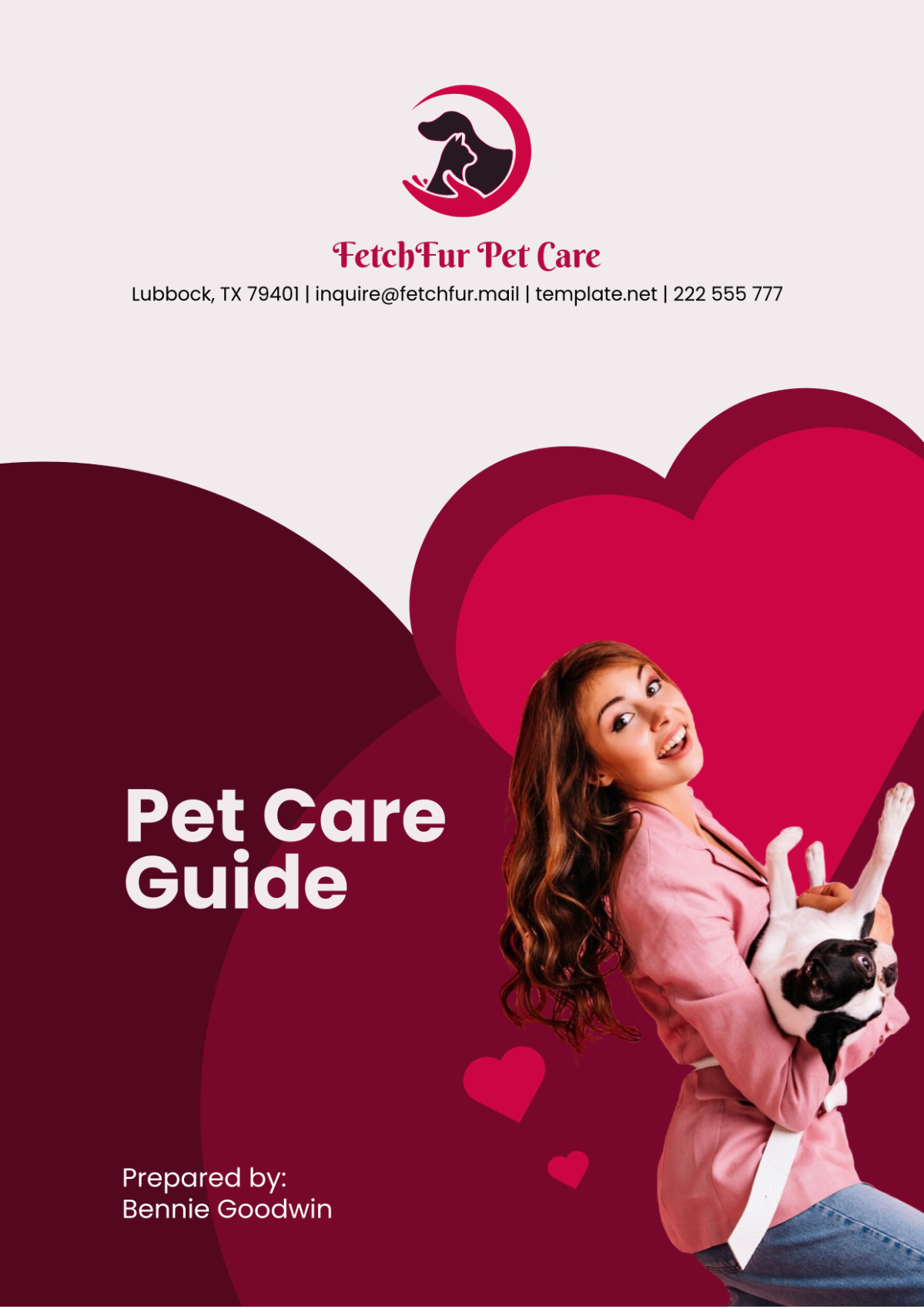Free Pet Care Guide

Introduction
Welcome to the comprehensive Pet Care Guide by [Your Company Name]. As we enter the year 2050 and beyond, pet care continues to evolve, with new trends, technologies, and practices that prioritize the health, well-being, and happiness of pets. Whether you're a first-time pet owner or have years of experience, this guide is designed to provide you with the most up-to-date information on how to care for your furry (or scaly) companions. This guide will cover a variety of topics, including pet selection, nutrition, health care, training, grooming, exercise, and emergency preparedness, ensuring you have all the resources needed for responsible pet ownership. We aim to help you build a lasting bond with your pet by offering practical advice and expert insights.
I. Choosing the Right Pet
A. Pet Types and Suitability
When selecting the perfect pet, it’s important to consider your lifestyle, the amount of time you can dedicate to your pet, your living environment, and the specific needs of the animal. Each pet type offers unique experiences, but not all pets will be a good fit for everyone.
1. Dogs
Dogs are one of the most beloved pets around the world, known for their loyalty, companionship, and the deep bond they create with their owners. They thrive in environments where they receive a lot of attention and care.
Temperament: Dogs are highly social animals and tend to form strong emotional bonds with their human companions. They are also highly trainable, making them excellent family pets or companions for active individuals.
Space Requirements: Large dog breeds, such as the Labrador Retriever or German Shepherd, typically require more space for running and playing, whereas smaller breeds like the French Bulldog or Dachshund can live comfortably in apartments. However, even small dogs need daily exercise to stay healthy.
Time Commitment: Dogs require significant attention. In addition to regular feeding, they need exercise and training. Daily walks and playtime are essential, and dogs generally need [2-3] hours of activity each day.
2. Cats
Cats are independent and low-maintenance pets that are perfect for people with busier schedules. Despite their independent nature, cats can form strong attachments to their owners and offer affection when they want it.
Temperament: Cats are typically more self-sufficient than dogs, often content to spend time alone. However, they still require interaction, especially in the form of play and companionship to prevent loneliness and boredom.
Space Requirements: Cats are highly adaptable to various living environments, from small apartments to large houses. They often find their favorite spots to sleep or play, and many enjoy climbing or scratching surfaces.
Time Commitment: Unlike dogs, cats do not require hours of attention each day, but they still need at least [30-60] minutes of interaction, including feeding, cleaning the litter box, and playtime.
3. Small Pets (Hamsters, Guinea Pigs, Rabbits)
Small pets like hamsters, guinea pigs, and rabbits are excellent choices for those with limited space or those looking for a lower-maintenance pet. However, small pets still require care and attention to ensure their well-being.
Temperament: Small pets are often less interactive than dogs or cats, but they can form bonds with their owners through gentle handling. Guinea pigs and rabbits enjoy social interaction and thrive in pairs or groups, while hamsters prefer solitary living.
Space Requirements: Small pets need cages or enclosures tailored to their size. Rabbits, in particular, benefit from having enough space to hop around and explore.
Time Commitment: These pets are low-maintenance compared to dogs and cats, with daily care usually involving feeding, cleaning, and occasional playtime. A daily time commitment of around [15-30] minutes is typically sufficient.
4. Exotic Pets (Reptiles, Birds, Fish)
Exotic pets can be a unique and fascinating addition to your household, but they often come with specialized care requirements. They may not be as interactive as dogs or cats, but they can still provide visual stimulation and companionship.
Temperament: Exotic pets such as reptiles and birds may not offer the same level of physical affection as traditional pets, but they can develop their own personalities and exhibit interesting behaviors. Some birds can even mimic human speech.
Space Requirements: Reptiles, fish, and birds all require specialized enclosures. Fish need aquariums, reptiles thrive in terrariums, and birds need cages that accommodate their size and allow for flight.
Time Commitment: Depending on the species, exotic pets may require more time for environmental maintenance and feeding. For example, fish may require tank cleaning every few weeks, while reptiles need temperature-controlled habitats and regular feeding. Average care time is [15] minutes to [1] hour daily.
II. Nutrition and Feeding
A. Dietary Needs by Pet Type
Proper nutrition is one of the most important aspects of pet care. A balanced diet is essential to ensure your pet stays healthy and happy. While pets may require different types of food depending on their species, all animals need high-quality ingredients for optimal health.
1. Dogs
Dogs are omnivores, meaning they can consume a wide range of foods. However, it’s important to provide them with a diet that meets their specific nutritional needs.
Protein and Fats: Dogs require a protein-rich diet to maintain strong muscles and a healthy immune system. The optimal balance for most dogs is about [25%] protein and [15%] fats. Look for dog food where meat is the first ingredient, such as chicken or beef.
Carbohydrates: Carbohydrates provide energy and fiber for digestion, though they should not be the primary component of the diet. Ideally, carbohydrates should make up around [40%] of a dog’s food.
Sample Daily Cost: High-quality dry dog food can cost between $[2-5] per day, depending on the brand and type of food.
2. Cats
Cats are obligate carnivores, which means they require a diet that consists mostly of animal-based proteins. Their bodies are designed to process meat, so it’s essential to avoid feeding them plant-based diets.
High Protein, Low Carbohydrate: A cat's diet should consist of at least [30%] protein, with minimal carbohydrates. Cats require protein to support their energy needs and maintain their muscle mass. Look for high-quality meat-based products without fillers like corn and wheat.
Taurine Requirement: Taurine, an amino acid found in animal tissues, is critical for a cat’s heart, vision, and reproductive health. Most high-quality cat foods contain added taurine to meet these nutritional needs.
Sample Daily Cost: Premium cat food can cost around $[1-3] per day, depending on the quality and type of food.
3. Small Pets
Small pets like guinea pigs, hamsters, and rabbits have very specific dietary needs, and a well-balanced diet is critical to their health. They primarily eat plant-based foods.
Vegetables and Hay: For guinea pigs and rabbits, hay should make up around [80%] of their diet. They should also have access to fresh vegetables, and their food should be supplemented with species-specific pellets.
Pellet Quality: When choosing pellets for small pets, it’s important to select those without artificial additives, sugars, or fillers, which can lead to health problems.
Sample Daily Cost: On average, small pets' food costs between $[0.50-1] per day, depending on the type of food and brand.
4. Exotic Pets
Exotic pets such as reptiles, birds, and fish each have very different dietary requirements based on their species.
Species-Specific Diets: Many reptiles eat a combination of insects, vegetables, and occasional fruits, while birds may require seeds, pellets, and fresh produce. Fish also require specific diets depending on whether they are herbivores or carnivores.
Live vs. Prepared Food: Some reptiles, like snakes, require live prey, such as mice or insects, while many fish and birds thrive on commercially prepared foods.
Sample Daily Cost: Daily feeding costs for exotic pets can vary significantly based on the species and their diet, with typical costs ranging from $[0.50-5] per day.
B. Feeding Schedules
Pet Type | Feeding Frequency | Portion Control |
|---|---|---|
Dogs | 1-2 times daily | Follow guidelines on dog food packaging based on weight |
Cats | 2-3 times daily | Smaller, frequent meals are ideal; prevent overeating |
Small Pets | Continuous access | Unlimited hay, measure pellets daily |
Exotic Pets | Varies | Tailored to species; reptiles may eat weekly |
III. Health and Wellness
A. Veterinary Care
Routine veterinary care is essential for maintaining your pet’s health and detecting any underlying issues early on. Regular visits ensure that your pet is up-to-date on vaccinations and preventive care.
1. Regular Checkups
Frequency: Most pets should see a veterinarian at least once a year for a routine checkup. Senior pets, especially dogs and cats, may require visits every six months to monitor for age-related conditions.
Cost of Care: The cost for an annual checkup typically ranges from $[100-200], depending on the clinic and your pet's needs.
2. Vaccinations and Preventative Care
Core Vaccinations: Vaccinations are crucial for preventing common diseases. Dogs should be vaccinated against rabies, distemper, and parvovirus, while cats need vaccinations for rabies and feline distemper.
Parasite Control: Regular treatments for parasites such as fleas, ticks, and worms are necessary to prevent health problems. Monthly preventatives typically cost between $[10-30] per month, depending on the type.
IV. Training and Behavioral Care
A. Basic Obedience Training
Training your pet is essential for establishing a well-behaved, happy companion. This includes teaching them basic commands, house training, and socializing with other pets and people.
1. Dog Training
Commands to Teach: Start with basic commands like "sit," "stay," and "come." These can help build a foundation for further training.
Positive Reinforcement: Reward-based training is the most effective method. Treats and praise motivate dogs to repeat desired behaviors.
Training Cost: Basic dog training classes can range from $[100-300] for a series of sessions.
2. Cat Training
While cats are less responsive to formal training than dogs, they can still learn behaviors like using the litter box and following certain commands.
Litter Training: Most cats instinctively use a litter box, but some may need extra guidance to get used to it. Keep the litter box clean, and place it in a quiet, accessible location.
Training Cost: Professional cat training is rare, but some cats can benefit from socialization sessions costing around $[50-150] depending on the service.
V. Grooming
A. Bathing, Brushing, and Nail Care
Regular grooming is vital for keeping your pet clean, healthy, and comfortable. This includes regular baths, brushing, and nail trimming.
1. Dogs
Dogs benefit from regular brushing, especially long-haired breeds, to prevent tangling and matting.
Brushing Frequency: Long-haired dogs should be brushed every day, while short-haired dogs can be brushed every few days.
Bathing: Bathing frequency depends on the dog’s breed and lifestyle. Active dogs may need a bath once every [3-4] weeks, while less active dogs can be bathed less frequently.
2. Cats
Cats are naturally clean animals and often groom themselves. However, regular brushing is necessary for certain breeds, like Persians or Maine Coons.
Brushing Frequency: Long-haired cats should be brushed every [2-3] days to avoid mats and tangles. Short-haired cats need brushing once a week.
Nail Clipping: Cats should have their nails trimmed every [2-4] weeks, especially if they are indoor cats who don’t naturally wear down their claws.
3. Small Pets
Small pets like guinea pigs and rabbits also require grooming.
Frequency: Regular brushing, especially for long-haired breeds, is essential to prevent matting. Small pets may need bathing less frequently, but their living areas must always be kept clean.
VI. Emergency Preparedness
A. First Aid Basics
1. Emergency Kit Essentials
An emergency kit for pets is an essential part of your preparedness plan. It ensures that you have the necessary tools to address medical emergencies immediately. The kit should include:
Bandages, gauze, and antiseptic wipes to manage wounds
Tweezers for removing splinters, ticks, or thorns
A pet thermometer to monitor temperature
Emergency contact information for your vet and nearby emergency animal clinics
2. Handling Common Emergencies
Being prepared for emergencies can make all the difference in a critical situation.
Poisoning: If you suspect your pet has ingested something harmful, try to determine the substance and contact your veterinarian or a pet poison hotline immediately.
Injury: For minor cuts, clean the wound with water and apply gentle pressure with a sterile bandage. For severe injuries, seek veterinary care immediately.
VII. Cost of Ownership
A. Annual Expenses Breakdown
Expense Category | Estimated Annual Cost Range |
|---|---|
Food | $500 - 1,500 |
Veterinary Care | $300 - 800 |
Grooming | $200 - 500 |
Training and Enrichment | $100 - 300 |
Toys and Supplies | $50 - 200 |
Total | $1,150 - 3,300 |
B. Pet Insurance
Pet insurance is becoming increasingly popular as it provides peace of mind in case of unexpected medical expenses.
Monthly Premiums: Expect to pay [$20]-[$50] per month for basic coverage.
Coverage Options: Policies can vary, with some covering only emergency accidents, while others may include comprehensive coverage for illnesses, surgeries, and even preventative care.
- 100% Customizable, free editor
- Access 1 Million+ Templates, photo’s & graphics
- Download or share as a template
- Click and replace photos, graphics, text, backgrounds
- Resize, crop, AI write & more
- Access advanced editor
Guide pet owners with the Pet Care Guide Template from Template.net. This editable and customizable guide offers tips, advice, and checklists for comprehensive pet care. Personalize it with our Ai Editor Tool for a tailored care guide that meets your clients' needs.





























